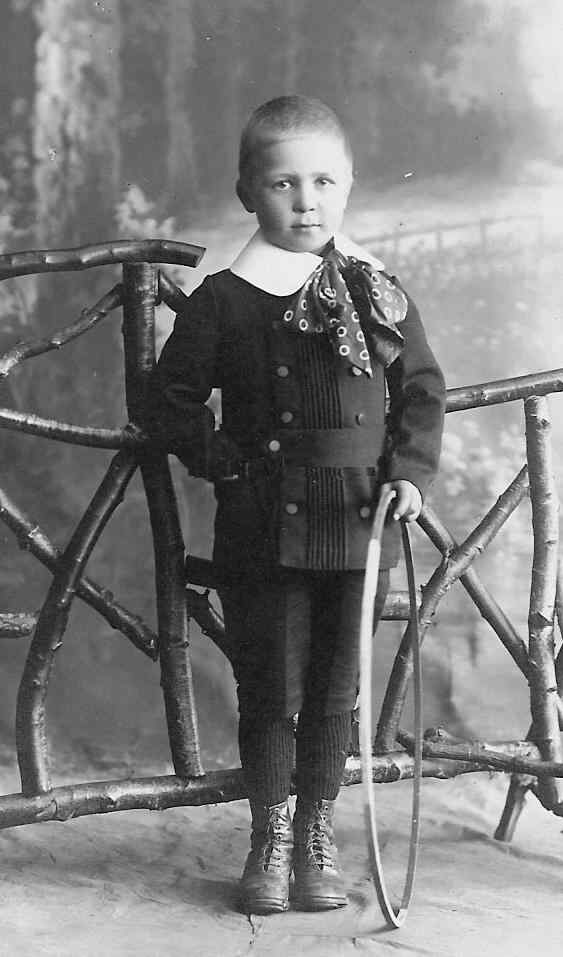
Boys' 1900s Pants and Trousers: Types

Figure 1.--Many boys in the 1900s wore knee pants. This portrait is unidentified, but we believe the boy was photographed in the 1900s, probably in Germany. He wears his suit with a latge white collar, floppy bow, and long stockings. The jacket has some Norfolk styling, but I am not sure you would call this a Norfolk jacket.
|
We note boys wearing a wide range of different trousers were commonly worn during the 1900s. More different types of trousers were worn during the 1900s than any other decade. Popular styles include kneepants, knickers, short pants, long pants, and a variety of one-piece suits like rompers. Most boys in the 1900s wore kneepants or long pants, although knickers were also common. There were some stylistic difference among these different trouser types. There were also major differences from country to country. Younger boys might also wear bloomer knickers, often with tunic suits. Tunic suits were very popular for younger boys in the 1900s. They were commonly worn wuth both knee pnts and bloomer knickers. Straight-leg kneepants were the most commomn type of boys' trousers at the turn of the century. The German boy here wearing knee pants is a good example (figure 1). We also see boys wearing knickers which became increasingly popular as the century progressed, escpecially in America. Baden Powell introduced his new Boy Scout uniform with short pants. New one-piece styles became popular in the early 20th century like rompers and coveralls.
Straight-leg kneepants were the most commomn type of boys' trousers at the turn of the century. The term straight-leg was used in comtemporary catalogs to destinguish between knee pants which were cut staight and knickers which were cut to blouse out, althogh for the most part knickers in the 1900s did not blouse out very much. The German boy here wearing knee pants is a good example of the kneepants commonly worn in the 1900s (figure 1). He looks to be about 7 years old. Kneepants were commonly worn in both Europe and America. We notice both pre-teens and teenagers wearing them. European boys seem to have shiften to long pants in their earky teens. We notice even older teens wearing kneepants in America. Not all older teens, but this seem to have been very common. Different families seemed to have different ideas here. There were also demographic and social-class differences.
Knickers
We also see boys wearing knickers in the 1900s. They seem to have been more common in Europe than in America. We also see boys wearing knickers which became increasingly popular as the century progressed, escpecially in America. Knickers and knee pants seem to have been to sone extent interchangeable. We see catalogs offerung knee pants and knicker suits in the same age range. We tend to see somewhat older boys wearing knickers, at least in Europe. We tend to see older British boys wearing knickers and they seem to have been worn more commonly by middle-class than working-class children. We see boys in private schools, for example, wearing knickers more than kneepants. I think the same social patterns were true on the Continent as well, but we have less information available.
Short Pants
Baden Powell introduced his new Boy Scout uniform with short pants (1907). We do not see boys wearing shorts much before this, except younger boys. Early horts wre so long that it is difficult to destinguish short pants from knee pants. Shorts begin to grow in popularity in Britain and Europe, but for some reason not in America.
Long Pants
Long pants were worn throughout the 19th century. They were also worn in the 1900s. They were not common for pre-teen boys, but we do see boys as young as 10 years of age wearing them. Here social class was a factor. This was a little complicated. Working-class boys were much more likelky to wear long pants than middle-class boys. One reason for this was they tended to leave school and begin working earlier. We note, however, that boys from wealthy families once they reached their teens, often wore long trousers while middle-class boys more commonly wore knee pants. One exception was the sailor suit. Some sailor suit even for younger boys were made with long pants. Most sailor suits were made with knee pants, but we see quite a few with long pants.
Bloomer Knickers
Younger boys might also wear bloomer knickers, often with tunic suits. Tunic suits were very popular for younger boys in the 1900s. They were commonly worn wuth both knee pnts and bloomer knickers.
Rompers
New one-piece styles became popular in the early 20th century like rompers and coveralls.
Coveralls
HBC

Navigate the Historic Boys' Clothing Web Site:
[Return to the Main 1900s trouser page ]
[Introduction]
[Activities]
[Biographies]
[Chronology]
[Cloth and textiles]
[Clothing styles]
[Countries]
[Topics]
[Bibliographies]
[Contributions]
[FAQs]
[Glossaries]
[Satellite sites]
[Tools]
[Boys' Clothing Home]
Navigate the Historic Boys' Clothing Web chronological pages:
[Early 19th century]
[Mid-19th century]
[The 1860s]
[The 1870s]
[The 1880s]
[The 1890s]
[The 1900s]
[The 1910s]
[The 1920s]
[The 1930s]
[The 1940s]
[The 1950s]
[The 1960s]
[The 1970s]
[The 1980s]
Navigate the Historic Boys' Clothing Web style pages:
[Skeleton suits]
[Eton suits]
[Norfolk jackets]
[Kilts]
[Knicker suits]
[Blazers]
[Short pants suits]
[Long pants suits]
Created: 1:05 AM 4/5/2006
Last updated: 12:38 AM 4/6/2006


